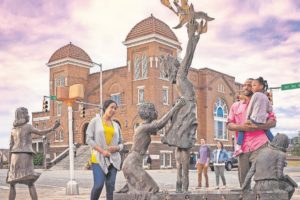A day trip to the state’s largest city can unveil some oft over-looked historical gems

By Lisa Elia | Living 50 Plus
BIRMINGHAM – For a city whose theater district once rivaled that of New York’s, it’s only fitting today that it’s undergoing a second act and the reviews, so far, are glowing.
From its foodie-loving restaurants that have filled once-shuttered storefronts to its green spaces that have breathed new life into rusted railroad tracks, Birmingham makes you want to stay awhile and enjoy its food, culture and history.
In its heyday in the early 20th century, the rapid growth and wealth that resulted from local iron and steel manufacturing earned Birmingham the nickname Magic City. During the Great Depression, growth sputtered and the city never came roaring back to full strength.
But today, things are turning around, with 20th century high rises downtown being renovated into trendy shops, bars, restaurants and tech businesses. But the city still gives a nod to its past.
Visitors can see examples of Birmingham’s golden age of cinema, when 26 theaters filled downtown. Today, only a few remain. The historic Alabama Theatre, where the “Mighty Wurlitzer” pipe organ occasionally plays, and the recently restored Lyric Theatre, which once hosted vaudevillian acts, are humming with top-notch performances.
Mineral-rich Red Mountain, part of the Appalachians, provided the natural elements of limestone, coal and iron ore that were churned in the Sloss Furnaces for the fiery brew that made pig iron. The furnaces closed in the early 1970s, and the building is now a museum. Visitors can see the city’s 56-foot Vulcan, the largest cast-iron statue in the world.
Railroad Park opened in 2010 and is called Birmingham’s living room. Its green space features a lake, walking and biking trails, a skate park and venues for outdoor entertainment.
The minor league baseball team Birmingham Barons play at the 8,500-seat Regions Field. Next to the stadium is the Negro Southern League Museum, which tells the history of black baseball in America through the eyes of the Birmingham Black Barons. It houses the largest collection of Negro League Baseball artifacts in the country, including pitcher Satchel Paige’s worn uniform.
The Civil Rights District is a six-block area that played host to rallies, demonstrations and confrontations in the 1960s. The Birmingham Civil Rights Institute is a repository of images and artifacts, including separate drinking fountains for white and black citizens.
Across the street is Kelly Ingram Park, ground zero for many of the defining moments of the civil rights movement. The 16th Street Baptist Church, where four girls were killed in a 1963 bombing, is part of the district, and tours are by appointment only.
One of the city’s main dining hubs is the tree-shaded Five Points neighborhood, featuring chef Frank Stitt’s James Beard award-winning restaurant Highlands Bar & Grill. There’s also The Pizitz Food Hall, once an upscale department store that now features Vietnamese food, Himalayan dumplings and Hawaiian poke. The Avondale neighborhood has attracted a fun batch of new restaurants and bars, such as the 1920s-style speakeasy The Marble Ring.
